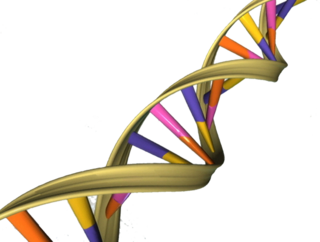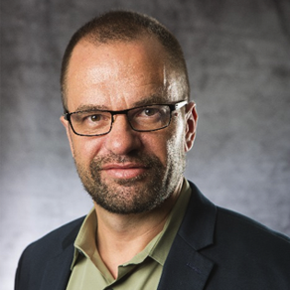Related Research Articles

In the fields of molecular biology and genetics, a genome is all the genetic information of an organism. It consists of nucleotide sequences of DNA. The nuclear genome includes protein-coding genes and non-coding genes, other functional regions of the genome such as regulatory sequences, and often a substantial fraction of junk DNA with no evident function. Almost all eukaryotes have mitochondria and a small mitochondrial genome. Algae and plants also contain chloroplasts with a chloroplast genome.

A transposable element is a nucleic acid sequence in DNA that can change its position within a genome, sometimes creating or reversing mutations and altering the cell's genetic identity and genome size. Transposition often results in duplication of the same genetic material. In the human genome, L1 and Alu elements are two examples. Barbara McClintock's discovery of them earned her a Nobel Prize in 1983. Its importance in personalized medicine is becoming increasingly relevant, as well as gaining more attention in data analytics given the difficulty of analysis in very high dimensional spaces.

Saccharomyces cerevisiae is a species of yeast. The species has been instrumental in winemaking, baking, and brewing since ancient times. It is believed to have been originally isolated from the skin of grapes. It is one of the most intensively studied eukaryotic model organisms in molecular and cell biology, much like Escherichia coli as the model bacterium. It is the microorganism behind the most common type of fermentation. S. cerevisiae cells are round to ovoid, 5–10 μm in diameter. It reproduces by budding.

Yeast artificial chromosomes (YACs) are genetically engineered chromosomes derived from the DNA of the yeast, Saccharomyces cerevisiae, which is then ligated into a bacterial plasmid. By inserting large fragments of DNA, from 100–1000 kb, the inserted sequences can be cloned and physically mapped using a process called chromosome walking. This is the process that was initially used for the Human Genome Project, however due to stability issues, YACs were abandoned for the use of Bacterial artificial chromosome

Retrotransposons are a type of genetic component that copy and paste themselves into different genomic locations (transposon) by converting RNA back into DNA through the reverse transcription process using an RNA transposition intermediate.
Peter G. Schultz is an American chemist. He is the CEO and Professor of Chemistry at The Scripps Research Institute, the founder and former director of GNF, and the founding director of the California Institute for Biomedical Research (Calibr), established in 2012. In August 2014, Nature Biotechnology ranked Schultz the #1 top translational researcher in 2013.
Jeffrey Lynn Bennetzen is an American geneticist on the faculty of the University of Georgia (UGA). Bennetzen is known for his work describing codon usage bias in yeast, being the first to clone and sequence an active transposon in maize, and developing and proposing along with Michael Freeling the model of the grasses as a single genetic system. He is one of two authors, with Sarah Hake of the book "Handbook of Maize." Bennetzen was elected to the National Academy of Sciences in 2004.
The Ty5 is a type of retrotransposon native to the Saccharomyces cerevisiae organism.

The mobilome is the entire set of mobile genetic elements in a genome. Mobilomes are found in eukaryotes, prokaryotes, and viruses. The compositions of mobilomes differ among lineages of life, with transposable elements being the major mobile elements in eukaryotes, and plasmids and prophages being the major types in prokaryotes. Virophages contribute to the viral mobilome.
Synthetic genomics is a nascent field of synthetic biology that uses aspects of genetic modification on pre-existing life forms, or artificial gene synthesis to create new DNA or entire lifeforms.

Artificial gene synthesis, or simply gene synthesis, refers to a group of methods that are used in synthetic biology to construct and assemble genes from nucleotides de novo. Unlike DNA synthesis in living cells, artificial gene synthesis does not require template DNA, allowing virtually any DNA sequence to be synthesized in the laboratory. It comprises two main steps, the first of which is solid-phase DNA synthesis, sometimes known as DNA printing. This produces oligonucleotide fragments that are generally under 200 base pairs. The second step then involves connecting these oligonucleotide fragments using various DNA assembly methods. Because artificial gene synthesis does not require template DNA, it is theoretically possible to make a completely synthetic DNA molecule with no limits on the nucleotide sequence or size.

Synthetic genetic array analysis (SGA) is a high-throughput technique for exploring synthetic lethal and synthetic sick genetic interactions (SSL). SGA allows for the systematic construction of double mutants using a combination of recombinant genetic techniques, mating and selection steps. Using SGA methodology a query gene deletion mutant can be crossed to an entire genome deletion set to identify any SSL interactions, yielding functional information of the query gene and the genes it interacts with. A large-scale application of SGA in which ~130 query genes were crossed to the set of ~5000 viable deletion mutants in yeast revealed a genetic network containing ~1000 genes and ~4000 SSL interactions. The results of this study showed that genes with similar function tend to interact with one another and genes with similar patterns of genetic interactions often encode products that tend to work in the same pathway or complex. Synthetic Genetic Array analysis was initially developed using the model organism S. cerevisiae. This method has since been extended to cover 30% of the S. cerevisiae genome. Methodology has since been developed to allow SGA analysis in S.pombe and E. coli.

LTR retrotransposons are class I transposable element characterized by the presence of long terminal repeats (LTRs) directly flanking an internal coding region. As retrotransposons, they mobilize through reverse transcription of their mRNA and integration of the newly created cDNA into another location. Their mechanism of retrotransposition is shared with retroviruses, with the difference that most LTR-retrotransposons do not form infectious particles that leave the cells and therefore only replicate inside their genome of origin. Those that do (occasionally) form virus-like particles are classified under Ortervirales.
Cryptic unstable transcripts (CUTs) are a subset of non-coding RNAs (ncRNAs) that are produced from intergenic and intragenic regions. CUTs were first observed in S. cerevisiae yeast models and are found in most eukaryotes. Some basic characteristics of CUTs include a length of around 200–800 base pairs, a 5' cap, poly-adenylated tail, and rapid degradation due to the combined activity of poly-adenylating polymerases and exosome complexes. CUT transcription occurs through RNA Polymerase II and initiates from nucleosome-depleted regions, often in an antisense orientation. To date, CUTs have a relatively uncharacterized function but have been implicated in a number of putative gene regulation and silencing pathways. Thousands of loci leading to the generation of CUTs have been described in the yeast genome. Additionally, stable uncharacterized transcripts, or SUTs, have also been detected in cells and bear many similarities to CUTs but are not degraded through the same pathways.

Fred Sherman was an American scientist who pioneered the use of the budding yeast Saccharomyces cerevisiae as a model for studying the genetics, molecular biology, and biochemistry of eukaryotic cells. His research encompassed broad areas of yeast biology including gene expression, protein synthesis, messenger RNA processing, bioenergetics, and mechanisms of mutagenesis. He also contributed extensively to the genetics of the opportunistic pathogen Candida albicans.

Fred Marshall Winston is the John Emory Andrus Professor of Genetics in the Harvard Medical School Genetics Department, where he has been a member of the faculty since 1983. Research in his laboratory has focused on mechanisms of transcription and the regulation of chromatin structure in the budding yeast Saccharomyces cerevisiae and the fission yeast Schizosaccharomyces pombe. Dr. Winston served as the President of the Genetics Society of America in 2009 and has been elected to both the American Academy of Arts and Sciences (2009) and the National Academy of Sciences (2013).
Synthetic genome is a synthetically built genome whose formation involves either genetic modification on pre-existing life forms or artificial gene synthesis to create new DNA or entire lifeforms. The field that studies synthetic genomes is called synthetic genomics.

Daniel Voytas, Ph.D., is Professor of Genetics, Cell Biology and Development at the University of Minnesota and Director of the Center for Precision Plant Genomics. He is also the Chief Scientific Officer of Calyxt, an agricultural biotechnology company focused on developing crops that provide consumer benefit.

The Genome Project - Write is a large-scale collaborative research project that focuses on the development of technologies for the synthesis and testing of genomes of many different species of microbes, plants, and animals, including the human genome in a sub-project known as Human Genome Project-Write (HGP-Write). Formally announced on 2 June 2016, the project leverages two decades of work on synthetic biology and artificial gene synthesis.
Metavirus is a genus of viruses in the family Metaviridae. They are retrotransposons that invade a eukaryotic host genome and may only replicate once the virus has infected the host. These genetic elements exist to infect and replicate in their host genome and are derived from ancestral elements unrelated from their host. Metavirus may use several different hosts for transmission, and has been found to be transmissible through ovule and pollen of some plants.
References
- ↑ "Scientists Synthesize First Functional "Designer" Chromosome in Yeast". Youtube. NYU Langone Health. May 27, 2014. Retrieved May 15, 2023.
I'm Jeff Boeke...
- 1 2 "About our director". NYU Langone Medical Center. Archived from the original on February 16, 2015. Retrieved March 2, 2015.
- ↑ "High Throughput Biology". Johns Hopkins Medical Institute. Archived from the original on September 22, 2019. Retrieved March 2, 2015.
- ↑ "Members of the American Academy of Sciences" (PDF). American Academy of Arts and Sciences. Retrieved March 2, 2015.
- ↑ "Members of the National Academy of Sciences". National Academy of Sciences. Retrieved March 2, 2015.
- ↑ "Alumni". Bowdoin College. Retrieved March 2, 2015.
- ↑ "Authors - Jef Boeke". Biomed Central. Retrieved March 2, 2015.
- ↑ Boeke, JD; Garfinkel, DJ (1985). "Ty elements transpose through an RNA intermediate". Cell. 40 (3): 491–500. doi:10.1016/0092-8674(85)90197-7. PMID 2982495. S2CID 24690915.
- ↑ Rose, Sam (June 12, 2014). "Jef Boeke on the lure of retrotransposons". Biomed Central.
- ↑ Shukman, David (March 27, 2014). "Scientists hail synthetic chromosome advance". BBC News. Retrieved March 28, 2014.
- ↑ Annaluru, Narayana; et al. (March 27, 2014). "Total Synthesis of a Functional Designer Eukaryotic Chromosome". Science. 344 (6179): 55–58. Bibcode:2014Sci...344...55A. doi:10.1126/science.1249252. PMC 4033833 . PMID 24674868.
- ↑ "Sc 2.0 project website" . Retrieved March 2, 2015.
- ↑ Callaway, Ewen (March 27, 2014). "First synthetic yeast chromosome revealed". Nature. doi: 10.1038/nature.2014.14941 . S2CID 88104990.